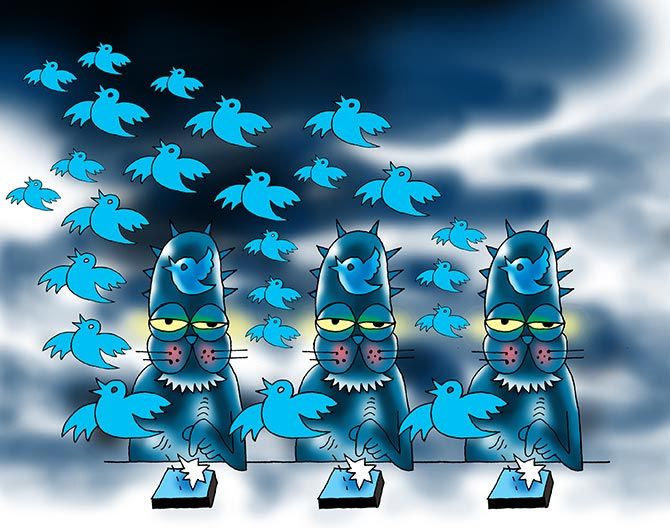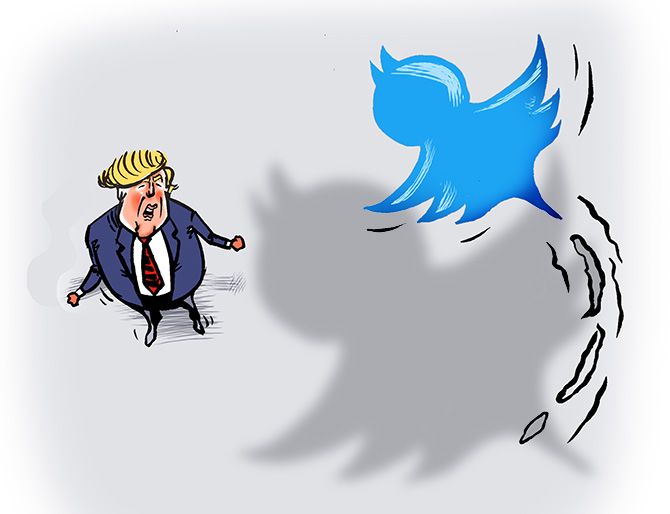'Any 21st-century political campaign will involve a lot of jockeying for social media territory.'
The higher the profile of the campaign, the more likely it is to draw freelancers.
Devangshu Datta surveys the Battle of the Bots.

Illustration: Uttam Ghosh/Rediff.com
On October 15, at 1.56 pm, the official Twitter account of Rahul Gandhi reacted to a tweet by US President Donald Trump praising American-Pakistani relations with this tweet: 'Modiji quick, looks like President Trump needs another hug.'
The tweet quickly zoomed to 30,000-plus retweets.
On October 21, news agency ANI carried a report claiming that Gandhi was using fake Twitter accounts -- so-called Twitter bots from Kazakhstan, Russia and other nations -- to retweet his tweets and thereby amplify the apparent popularity of his account.
The story showed screenshots of several automated Twitter accounts that retweeted that Trump tweet.
This story was seized upon gleefully by the Bharatiya Janata Party. Its social media cell spread the story far and wide using hashtags like #RahulWaveinKazakh.
BJP Minister Smriti Irani made snide remarks to the effect that Gandhi intended to win elections in Russia and Kazakhstan.
The Congress social media team responded quickly by pointing out several oddities about the Twitter bots that were cited in the story.
These accounts had been created several days after Gandhi had made that Trump-related tweet. These accounts specifically stated location data (which can be turned on and off at will) allowing them to be identified as Kazakh and Russian accounts.
The BJP IT cell had also started publicising the ANI story a couple of hours before it was actually released -- a sign that it was clearly in the know of the whole affair.
Divya Spandana, who manages social media and digital communication for the Congress, said the story was 'factually wrong' and many experts said that this looked like a clumsily faked sting operation where the bots had been created by right-wing supporters to try and embarrass Gandhi.
This is the latest instalment in the ongoing battle to win visibility on social media.
The BJP has the largest and most organised social media apparatus and Prime Minister Narendra D Modi himself has over 38 million followers compared to Rahul Gandhi's relatively measly 3.9 million.
But the Congress is pushing hard to increase its social media visibility and the Aam Aadmi Party is also pretty good at managing the Twittersphere.
The Congress' social media wing categorically says that it would not use bots to try and generate Twitter volume.
But despite the Congress' assurances, fake Twitter accounts will almost certainly be deployed by all sides in this battle for social media visibility.
In fact, fake accounts controlled and deployed by neutral third parties could end up operating freelance on both sides!

Illustration: Dominic Xavier/Rediff.com
Any 21st-century political campaign will involve a lot of jockeying for social media territory.
The higher the profile of the campaign, the more likely it is to draw 'freelancers'.
Both the Twitter accounts of Modi and Gandhi have a huge number of fake followers and many of those are freelance.
Every high-profile account attracts bots.
Bot controllers seek out high-profile, high-volume accounts that they can follow and retweet in the hope of gaining more followers themselves.
For example, a European escort service used to follow Modi and faithfully retweeted him for a while, in between shilling for clients!
It may seem absurd that an overseas escort service would attempt to gain traction from the Swachh Bharat Mission, but that is the absurd way in which social media sometimes works.
Following and retweeting a high-profile account is a low-cost way to gain some visibility.
Perhaps only one out of every million real followers will notice the fake account, but it's a free ride.
If a hacker controls 10,000 bots (and that's not impossible), he can multiply his chances of being noticed.
It's even cheaper than the old game of sending out spam emails. That involved buying e-mail databases.
Twitter is a free service with most accounts publicly visible.

Illustration: Dominic Xavier/Rediff.com
Trump's presidential campaign is known to have gained traction from one such freelance operation.
Macedonia is one of several tech-savvy Eastern European nations where exploiting social media to garner ad revenue is a popular form of entrepreneurship.
In the final weeks of the US presidential election, the small town of Veles in Macedonia attained short-lived fame because at least 100 pro-Trump Web sites were being run out of there. Many were filled with blatant fake news such as Trump slapped a voter on the campaign trail; Hillary Clinton faced criminal charges; the Pope endorsed Trump, and so on.
In early 2016, a tech-savvy teenager from Veles was running multiple blogs, cut-pasting content on a dozen different topics (sports, politics, health care) in the hope of generating ad revenue.
He discovered that news about Trump generated lots of views, which of course translated into better advertising revenue.
He also set up similar blogs extolling Bernie Sanders and Clinton, but Trump supporters seemed more gullible and generated more ad clicks.
 Illustration: Dominic Xavier/Rediff.com
Illustration: Dominic Xavier/Rediff.com
So he focussed on Trump, setting up Web sites like PoliticsHall.com and USAPolitics.co to ride the Trump campaign. He sourced content from dozens of obscure right-wing pro-Trump American sources, directly cut-pasting.
He created Facebook groups with names like 'My America, My Home'; 'The Deplorables' and 'Friends Who Support President Donald J Trump' to publicise the content.
He and his equally tech-savvy friends created fake Facebook profiles and fake Twitter accounts to push those links out.
Each of those stories was immediately discredited by mainstream media, but that didn't matter.
Social media is a bubble and many Trump supporters continued to believe the lies. It all fell apart after the election, but by then the Macedonians had made their pile.
It wasn't just the Macedonians, of course. The Trump campaign is reckoned to have had four times as many bots working in its favour compared to the Clinton campaign.
By the final stages, the Trump bots were generating seven times as much Twitter volume on the relevant hashtags.
The Trump campaign spent millions crafting its Facebook-Twitter campaign and micro-targeting the message to suit specific swing states.
And, of course, the Russians are alleged to have helped Trump for their own reasons.
The Brexit campaign had a similar high-bot presence.
Lies and fake statistics were generated by the pro-Brexit camp and then propagated by the use of these automated mechanisms. It worked.
It was only after the referendum that a lot of Brexit voters realised that they had been sold a dummy.
- Part 2: The Coming Battle of the Bots











